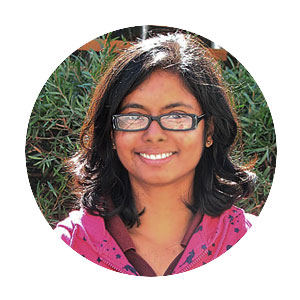Chandrima has an excellent knack for conveying the complexity of her work into accessible terms. Stemming from a presentation she gave last year at a Clinical Trials Support Office event, she was interviewed for their newsletter:
The Australian Cancer Research Foundation (ACRF) Image X Institute is a centre for innovation in radiation therapy and cancer imaging technologies and is part of the Faculty of Medicine and Health. Postdoctoral fellow Dr Chandrima Sengupta shares the story of her journey in medical research thus far and tells us about the exciting research she’s conducting.
Can you tell us about your studies and career thus far?
I was born and brought up in Kolkata, India, and completed my BSc and MSc in physics at the University of Calcutta.
I moved to Australia in 2015 to do a PhD in nuclear physics at the Australian National University. This was a great experience for me to explore the new culture and people around me, learning science and new techniques, and of course learning to speak in English 😊.
I joined the ACRF Image X Institute as a Postdoctoral Fellow in 2019 and since then have been working on improving radiation therapy treatment by developing and implementing new imaging and treatment technologies.
What made you decide to go into medical research?
Medical research is a field where you can directly see the impact of your work. It’s a huge satisfaction to see work that starts as some mathematical equations being used to treat and improve the lives of cancer patients.
With the new proton therapy centre being built in Adelaide, I think from a career perspective there will be lots of research opportunities in this field in Australia. Medical research is being heavily promoted by the Australian Government and the future looks bright.
Can you tell us about the trials you are currently working on and how the outcomes will impact on people’s lives?
I am currently involved in a few clinical trials, but let’s focus on the TROG 17.03 LARK trial (Liver Ablative Radiotherapy utilising Kilovoltage Intrafraction Monitoring).
The human body is dynamic. During radiation therapy treatment, some tumours, such as liver tumours, can move up to a few centimetres from a planned position, mostly due to breathing motion. This is a problem because if we don’t know the precise tumour position during a treatment, the radiation beam may not hit the tumour and may radiate the nearby healthy tissues.
We have a technology developed at the University of Sydney called Kilovoltage Intrafraction Monitoring, or KIM, that can detect the tumour motion and guide the treatment team to correct for the motion by shifting the radiation beam or the treatment couch.
In the LARK trial, our aim is to quantify the tumour tracking accuracy of KIM and delivered dose with KIM guidance, as compared to the standard of care treatment.
We have shown that KIM can be easily integrated with the current standard of care radiation therapy systems, and no extra cost is involved for its clinical implementation. This is significant because existing tumour motion monitoring technologies are way too expensive and hence inaccessible to most cancer patients.
Thus far we have found that with KIM guidance we can deliver radiation to within 1.5 mm accuracy, even if the patient is moving, and the average treatment time is shorter than the current standard of care treatment time.
Our ultimate aim is to deliver a higher dose of radiation with higher accuracy in smaller treatment time at no extra cost, making radiation therapy treatment easier and accessible to all cancer patients and reducing burden on the health system.
What excites you about your role in clinical trials?
We are currently running the LARK trial at three sites across Australia, with three new sites soon to be active. When visiting other sites I get to know the radiation therapy treatment workflow at these centres, as well as the people involved. This in turn gives me ideas for further improvements in treatment workflow and opens up the possibility of new collaborations.
And what are some challenges?
While running a clinical trial is a fulfilling experience, it is also a challenging one with plenty of responsibility – we need to ensure that our technology is safely implemented in the clinic.
I am the first point of contact when any decision needs to be made for KIM operation before and during a patient’s treatment. This was stressful when I first started my job, but having found I’ve been able to handle it over these past two years – with lots of help from my supervisors Professor Paul Keall and Dr Doan Nguyen – I now enjoy facing and solving all these difficult problems.
What’s your top tip for people wanting to get into medical research?
At the end of my PhD, when I was applying for postdoc positions in medical research, I got a few rejections saying that while I had a great profile, I didn’t have relevant experience in medical physics. So, if you are from a different research field like me, it may be hard at the beginning to get a position in medical research, but don’t give up.
As mentioned earlier, there are lots of interesting topics in this field and we will see many more in the near future. Dive into it!
Lastly, here’s a list of clinical trials, researchers from Image X are conducting:image-x.sydney.edu.au/clinical-trials/
See the full newsletter here: https://sway.office.com/TzwgbxrNHCLqtDpj?ref=Link
